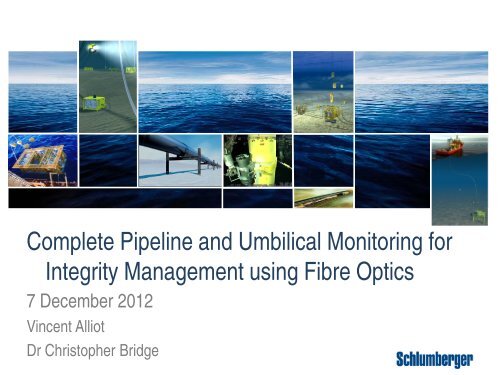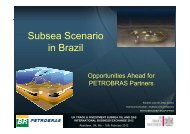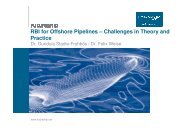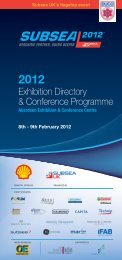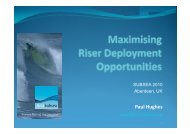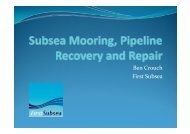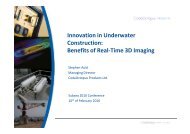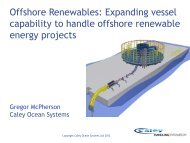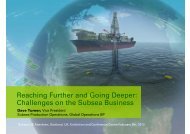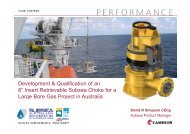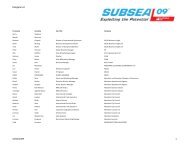Schlumberger - Subsea UK
Schlumberger - Subsea UK
Schlumberger - Subsea UK
Create successful ePaper yourself
Turn your PDF publications into a flip-book with our unique Google optimized e-Paper software.
Complete Pipeline and Umbilical Monitoring for<br />
Integrity Management using Fibre Optics<br />
7 December 2012<br />
Vincent Alliot<br />
Dr Christopher Bridge
Overview<br />
• <strong>Subsea</strong> asset monitoring generalities:<br />
– Purposes and value of monitoring<br />
– What events on what system or asset<br />
– Measurement system objectives<br />
• Fibre Optics background<br />
– Discrete measurement<br />
– Distributed measurement<br />
• Application of fibre optics in pipelines and umbilicals<br />
– Fibre Optic integration into the subsea asset<br />
– Pilot projects: pipelines and umbilicals<br />
• Conclusions
The Overall Objectives of Pipelines and Umbilicals<br />
Power<br />
Communication<br />
Fluid Transport<br />
System Integrity<br />
Supply power to subsea infrastructure<br />
Send and receive data from surface to subsea<br />
Keeping the hydrocarbon flowing<br />
Preventing or mitigate a leak
Where does Surveillance Fit?<br />
Environmental<br />
Wave<br />
Current<br />
Wind<br />
Structural Monitoring<br />
Tension<br />
Bending<br />
Vibration / Motion<br />
Fatigue – VIV, wave<br />
Pipe / soil interaction<br />
Conductor integrity<br />
Crack growth / existence<br />
Wall thickness / corrosion<br />
Fluid Properties<br />
Temperature<br />
Top<br />
Tensioned<br />
Riser<br />
Pressure<br />
Fluid flow<br />
Breakage<br />
Blockage<br />
Hydrate formation<br />
Change<br />
Other<br />
Vessel motions – GPS, 6 dof<br />
Wellhead<br />
Conductor<br />
Vessel<br />
Steel<br />
Riser<br />
Pipe<br />
Mooring<br />
Line<br />
Rigid<br />
Structure<br />
Vessel or<br />
Platform<br />
Tendon<br />
Catenary<br />
Riser<br />
Offloading<br />
Line<br />
Steel or<br />
Flexible<br />
Riser Pipe<br />
ROV<br />
<strong>Subsea</strong><br />
Equipment<br />
Vessel<br />
Umbilical<br />
Flexible<br />
Jumper<br />
Hybrid Riser<br />
Flowline<br />
Sea Level<br />
Air Can<br />
Steel<br />
Riser<br />
Pipe, or<br />
Bundle<br />
Foundation<br />
Seabed
Monitoring=Information to make decision ($value)<br />
• Is my component fit-for-purpose?<br />
– Inspection<br />
• Have I used the design life of my component yet?<br />
– Life Extension<br />
• When and how can I plan this operation?<br />
– Operational planning and Optimisation<br />
• Is this system performance range acceptable?<br />
– Operational Mediation<br />
• Can I do thing in a better way in the future?<br />
– Measurable performance = Knowledge Building
Purpose of Monitoring
Integrity Management<br />
Knowledge Building<br />
Asset Integrity<br />
Inspection, Maintenance and<br />
Repair<br />
Life Extension<br />
Operational<br />
Enhancement<br />
Operational<br />
Prevention<br />
Operational<br />
Mediation
Controlling Hazards to Prevent Failure<br />
An example of a hazard, event and consequence using structural<br />
integrity to prevent or mitigate a leak<br />
Hazard<br />
Prevention<br />
Event<br />
Mitigation<br />
Consequence<br />
Loss of Wall<br />
Unforeseen<br />
Interaction<br />
Causes<br />
Wear<br />
Crack<br />
Fracture<br />
Plastic Deformation<br />
Corrosion<br />
Fatigue<br />
Design<br />
Management<br />
= IMR plan<br />
Leak<br />
No Fluid Flow<br />
Reduced Fluid Flow<br />
Response<br />
Detect =<br />
Alarms<br />
Loss of Oil<br />
Environmental Disaste<br />
Human Casualty<br />
Loss of Reputation<br />
Financial Loss<br />
We work in the prevention and mitigation areas to<br />
- Manage hazards<br />
- Detect events
Potential Events of Interest<br />
• Fatigue<br />
• Leaks<br />
• Third party interference<br />
• Object tracking<br />
• Shark attack<br />
• Marine growth<br />
• Accidental damage<br />
• Excessive loading<br />
• Break or excessive strain<br />
• VIV<br />
• Wave loading<br />
• Second order vessel motions<br />
• Fluid properties<br />
– Fluid flow<br />
– Fluid temperature<br />
– Fluid pressure<br />
– Fluid content<br />
– Fluid slugging<br />
– Fluid flow restriction<br />
identification<br />
• Pipeline walking<br />
• Pipe/Soil interaction<br />
• Corrosion
Qualitative Assessment of Events - Classification<br />
• Period - the change caused by the effect to be observed:<br />
– Static Period of over 10 minutes,<br />
– Quasi-Static Period of between 1 minute and 10 minutes,<br />
– Dynamic Period of between 1 second and 1 minute,<br />
– Vibration Period less than 1 second.<br />
• Duration - the length of time taken for the event to initiate and<br />
finish/complete, described by:<br />
– Quick Event completes in a matter of seconds,<br />
– Short Event completes in a few minutes,<br />
– Long Event completes in a number of hours,<br />
– Continuous Event always occurs.<br />
• Occurrence - an indication of how often and the regularity of the event,<br />
defined by:<br />
– Sudden One off occurrence cannot be predicted,<br />
– Intermittent Repeated occurrences without regularity,<br />
– Regular Repeated regular occurrences,<br />
– Continuous Occurs all the time.
Qualitative Assessment of Events<br />
Event Period Duration Occurrence<br />
Fatigue Dynamic, Vibration Continuous Continuous<br />
VIV Dynamic, Vibration Continuous Continuous<br />
Excessive loading<br />
Static, Quasi-Static,<br />
Dynamic<br />
Short or Continuous<br />
Sudden<br />
Shock Loading Vibration Quick Sudden<br />
Force Monitoring<br />
Static, Quasi-Static,<br />
Dynamic<br />
Change, Drift<br />
Continuous<br />
Shape Monitoring Static Long Regular<br />
Third party interference Dynamic, Vibration Quick, Change Sudden<br />
Fluid Properties<br />
Static, Dynamic,<br />
Vibration<br />
Change<br />
Sudden<br />
Leak Dynamic, Vibration Change Sudden
Measurement System Objectives<br />
• Event detection<br />
– Along length of pipeline and umbilical detect events that<br />
occur,<br />
– Track and report changes in system<br />
– Identify what the event is, such as a leak,<br />
• Fatigue tracking<br />
– Monitor strains at critical locations, such as<br />
• Bend stiffener, Lazy wave, Touch down point, etc<br />
– Track fatigue damage to determine the usable life left within<br />
structure<br />
• Knowledge development<br />
– All measurements provide the ability to improve and develop<br />
knowledge of the measurand
Why Fibre Optics?<br />
• A single optical fibre provides over long distance the<br />
following:<br />
– Sensing element, and,<br />
– Power supply (light) transfer mean<br />
– Communications highway all in one<br />
• High and flexible spatial resolution measurement<br />
– Discrete measurements with many Bragg gratings (strain sensors)<br />
– Distributed measurements with backscattering light interpretation<br />
– Easy integration/interface with subsea structural assets<br />
• Compliant with subsea asset and associated environment<br />
– Generally subsea electric power is not required<br />
– Measurement not subject to electromagnetic interference<br />
– Not sensitive to humid environment<br />
• Robust measurement
Discrete Strain Sensing Technology<br />
●<br />
FBG “written” in to fibre core<br />
Λ<br />
Reflected<br />
Light<br />
Apply strain to fibre<br />
Reflected<br />
light<br />
Wavelength<br />
FBG wavelength increases<br />
linearly with applied<br />
strain<br />
Direct Strain Measurement<br />
No Calibration Required
Discrete Strain Sensing Technology<br />
Light<br />
Source<br />
Emitted light<br />
from light source<br />
t 1 t 2 t 3 t 4 t 5 t 6 t 7 t 8<br />
Reflected light received<br />
at different timeslots<br />
Reflected light<br />
from FBGs<br />
g1<br />
Sensor<br />
array<br />
Processor<br />
g6
Fibre Optics for Point Measurements
DTS Measurement Principle<br />
Incident Laser Light<br />
Backscattered Light<br />
DTS System<br />
Strain<br />
Vibration<br />
Laser Source<br />
Directional Coupler<br />
Temperature<br />
sensitive<br />
Receiver<br />
ΔT<br />
Backscattered Light<br />
(for every meter of the fibre optics)<br />
Fiber Optics Cable<br />
Not Temperature<br />
sensitive<br />
MV<br />
17
Potential Distributed Measurements<br />
Scattering Effect Attenuation Temperature Strain Vibration Acceleration<br />
Rayleigh X X X<br />
Raman X X<br />
Brillouin X X X X
Events and Measurement Technology<br />
Brillouin Raman Raleigh<br />
Event<br />
Bragg<br />
Grating<br />
DSTS hDSTS DTS DVS hDVS<br />
Fatigue Local NA Global NA NA NA<br />
VIV Local NA Global NA NA Global<br />
Excessive loading Local NA Global NA NA NA<br />
Shock Loading Local NA Global NA Global Global<br />
Force Monitoring Local Global Global NA NA NA<br />
Shape Monitoring Local Global Global NA NA NA<br />
Third party<br />
interference<br />
Local NA Global NA Global Global<br />
Fluid Properties Local Global Global Global NA NA<br />
Leak NA NA NA Global Global Global
Event Detection<br />
• Events along umbilical detected using<br />
– DSTS distributed strain and temperature sensing<br />
– DTS distributed temperature sensing<br />
– DVS distributed vibration sensing<br />
• Top side equipment and software to learn how the umbilical<br />
performs and identify significant events<br />
• From events identify leaks and report to operator<br />
• Technology status<br />
– Distributed measurements exist and can detect changes<br />
– Working to improve the understanding of how operating<br />
environment will effect measurements<br />
– Taking measurements from laboratory to field<br />
20
Illustration of Signals Strength from a Leak<br />
Signal<br />
Strength<br />
Temperature<br />
Noticeable<br />
Pressure Drop<br />
Vibration<br />
Pin Hole<br />
Small<br />
Large<br />
Pipe Diameter<br />
Hole<br />
Diameter
Fatigue Tracking with Bragg Grating<br />
• Using point strain measurements track strains at<br />
– approximately 8 Hz sample rate<br />
– at up to 50 locations per fibre optic strand<br />
• Convert into orthogonal bending strains and determine<br />
fatigue damage along measured umbilical lengths<br />
• Technological status<br />
– Fibre optics Bragg gratings used many times in the field for<br />
bending<br />
– Drift effects can be removed<br />
– Comprehensive coverage using multiple fibre optic strands<br />
and interrogators
Strain to Fatigue Damage<br />
• Processed in real time using 20 minute samples<br />
• Which results are required?<br />
– Cumulative fatigue damage<br />
– Fatigue damage rate<br />
– Stress histogram<br />
– Stress spectra<br />
– Stress timetraces<br />
y A<br />
Y Axis<br />
θ A<br />
Point A<br />
X Axis<br />
270°<br />
315°<br />
y A<br />
45°<br />
Stress Data<br />
S-N Curve<br />
Y Axis<br />
Y axis<br />
θ A<br />
x A<br />
45°<br />
Point A<br />
X Axis<br />
X axis<br />
Covert Stress Data into<br />
Stress Histogram<br />
Compare Number of<br />
Cycles Occurred to<br />
Maximum Number of<br />
Cycles Allowable<br />
Output Fatigue Damage<br />
and Fatigue Damage<br />
Rate<br />
x A<br />
225°<br />
135°<br />
180°
Fibre Optics Embedded into Composite Material<br />
<strong>Schlumberger</strong> Private
Flexible pipe annulus<br />
Annulus<br />
Outer sheath:<br />
Damage <br />
water ingress<br />
Carcass<br />
Pressure vault:<br />
Diffusion of water<br />
Ageing rupture<br />
Armours (carbon steel):<br />
Corrosion and fatigue<br />
rupture
<strong>Schlumberger</strong> Flat Pack Cable<br />
Single optical fibre containing multiple Bragg gratings in fibre optical bundle.<br />
Other optical fibres in bundle allow distributed measurements or are spare<br />
Extruded Plastic<br />
Coating<br />
Extruded Plastic<br />
Coating<br />
Distributed fibre optics in<br />
steel tubes
<strong>Schlumberger</strong> Flat Pack Cables<br />
Distributed<br />
Temperature<br />
Sensing for<br />
DSTS<br />
Strain<br />
Sensing<br />
Distributed<br />
Vibration<br />
Sensing<br />
Fibre Optic<br />
Cable<br />
Steel Tube<br />
Extruded<br />
Plastic<br />
Casing<br />
Bragg<br />
Grating<br />
Single Mode<br />
Cable<br />
Multi Mode<br />
Cable<br />
– Strain –<br />
Temperature<br />
(10 m res)<br />
Strain<br />
(10 m res)<br />
Strain,<br />
Vibration,<br />
Temperature<br />
(1 m res)<br />
Vibration<br />
(10 m res)<br />
Point<br />
Measurement<br />
Distributed<br />
Measurement<br />
Distributed<br />
Measurement
Strain Measurements in Pipelines and Umbilicals<br />
• Strains measured on steel tube at four locations around<br />
circumference<br />
• Four locations allows determination of bi-axial bending and<br />
tension
Example of Pipeline Incorporating <strong>Schlumberger</strong><br />
Flat Pack Cable
Generic Monitoring System for Cylindrical Structures<br />
Measurement<br />
Length<br />
Spatial<br />
Resolution<br />
Measurement<br />
Resolution<br />
Temperature 15 km 1 m 0.3 °C<br />
Accuracy,<br />
Precision<br />
1 °C<br />
±4 °C<br />
Sample Rate<br />
10 minutes<br />
Vibration 100 km 10 m - - 5 seconds<br />
Strain 50 km 10 m
Monitoring System Architecture<br />
• Simplified diagram<br />
– <strong>Schlumberger</strong> flat<br />
pack cable<br />
– Fibre optic<br />
interrogators<br />
– Data logging and<br />
storage<br />
– Interpretation<br />
– Display<br />
– Remote storage<br />
– Off site access to data<br />
Data Logging<br />
Fibre Optic<br />
Interrogator(s)<br />
Access for<br />
Engineering,<br />
Analysis and<br />
Health Check<br />
Communications<br />
to Remote<br />
Storage<br />
Local Storage,<br />
Data Processing<br />
and<br />
Interpretation<br />
Flat Pack Cable in<br />
Pipeline or Umbilical<br />
Onsite Display<br />
providing<br />
Actionable<br />
Information
Top Side System<br />
• Flat pack cables connect to<br />
fibre optic interrogators<br />
• Two hardware systems<br />
– Event detection<br />
– Fatigue tracking<br />
• One display system<br />
• One historian
Top Side Wiring<br />
Control Room Top Side Cabling Flat Pack Cable<br />
Junction Box<br />
Junction Box Tails<br />
Pipeline or<br />
Umbilical<br />
Fatigue<br />
Tracking<br />
Event<br />
Detection<br />
Control Room<br />
12 fibre optic Bragg<br />
grating arrays to<br />
fatigue tracking<br />
20 single mode and 8<br />
multi-mode fibre optic<br />
cables to Event<br />
detection<br />
Junction<br />
Box<br />
Distributes<br />
fibre optics to<br />
interrogators<br />
Cabling<br />
Transports 40 fibre optic<br />
cables from umbilical to<br />
control room<br />
Junction<br />
Box<br />
Terminates<br />
flat pack<br />
cables and<br />
connects to<br />
top side<br />
cables<br />
Tails<br />
Four flat pack cables<br />
run from umbilical to<br />
junction box.
Complete Pipeline Monitoring<br />
• <strong>Schlumberger</strong> has been working with clients to<br />
realise complete pipeline and umbilical monitoring<br />
capability<br />
• Providing real time<br />
– Event detection and identification,<br />
– Fatigue tracking<br />
• Measurements a laboratory and field proven,<br />
• The application is in development<br />
• Field trials planned for 2014
Accuracy, Precision and Resolution<br />
Criterion<br />
Accuracy<br />
Precision<br />
Repeatability<br />
Resolution<br />
Definition<br />
is the degree of exactness which the final product corresponds to the<br />
measurement standard.<br />
refers to the ability of a measurement to be consistently reproduced. May also<br />
be termed noise<br />
refers to the consistency of accurate results over consecutive measurements<br />
over time.<br />
the smallest increment that is digitally measured


